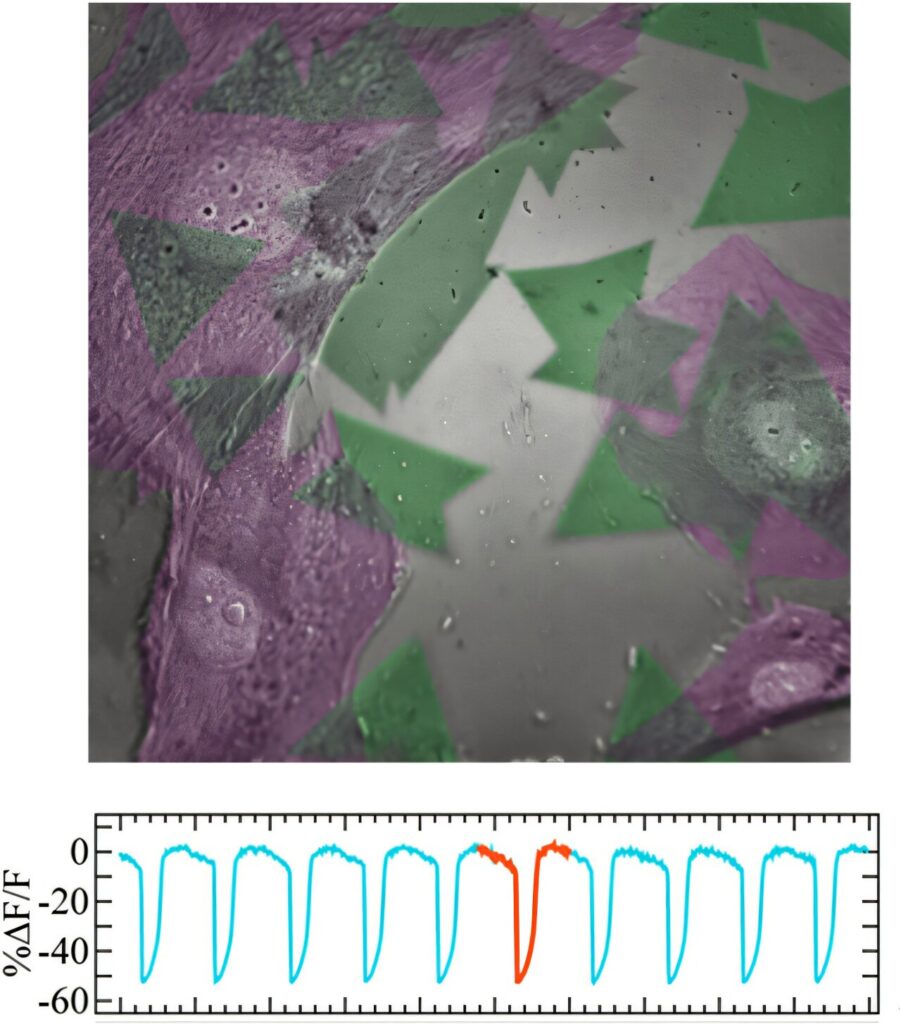For decades, scientists have relied on electrodes and dyes to track the electrical activity of living cells. Now, engineers at the University of California San Diego have discovered that quantum materials just a single atom thick can do the job—using only light.
A new study, published in Nature Photonics, shows that these ultra-thin semiconductors, which trap electrons in two dimensions, can be used to sense the biological electrical activity of living cells with high speed and resolution.
Scientists have continually been seeking better ways to track the electrical activity of the body’s most excitable cells, such as neurons, heart muscle fibers and pancreatic cells. These tiny electrical pulses orchestrate everything from thought to movement to metabolism, but capturing them in real time and at large scales has remained a challenge.
Traditional electrophysiology, which relies on invasive microelectrodes, offers precise recordings but is limited in scalability. Implanting electrodes across large regions of tissue can cause significant damage, and even the most advanced probes are limited to recording just a few hundred channels at once.
Optical techniques like calcium imaging, while capable of monitoring large populations of cells, offer only an indirect glimpse into electrical activity. Instead of recording the actual voltage shifts that drive cellular communication, they capture secondary changes that can introduce significant discrepancies.
UC San Diego engineers have demonstrated a new approach that could bridge this gap: a high-speed, all-optical method for recording voltage changes using atom-thick semiconductors. The key lies in how these materials’ electrons interact with light: When exposed to an electric field, they switch between two states—excitons (electron-hole pairs that are electrically neutral) and trions (charged excitons).
The researchers found that the conversion from excitons to trions in atom-thick semiconductors can be harnessed to detect the electrical signals of heart muscle cells—without the need for tethered electrodes or voltage-sensitive dyes, which can interfere with cellular function.
In other words, the quantum properties of the material itself can be used as a sensor.
“We believe that the voltage sensitivity of excitons in monolayer semiconductors has the potential to enable high spatiotemporal investigation of the brain’s circuitry,” said study senior author Ertugrul Cubukcu, a professor in the Aiiso Yufeng Li Family Department of Chemical and Nano Engineering, as well as the Department of Electrical and Computer Engineering, at the UC San Diego Jacobs School of Engineering.
Cubukcu and his team studied the quantum properties of monolayer molybdenum sulfide. In addition to its biocompatibility, they found that this semiconductor material possesses a particular advantage: It naturally forms sulfur vacancies during its production, which creates a high density of trions. This built-in defect makes it exceptionally responsive to changes in nearby electric fields, including the ones generated by living cells, which in turn allow spontaneous exciton-to-trion conversion.
By tracking changes in the material’s photoluminescence, the researchers could map the electrical activity of heart muscle cells in real time, at speeds unmatched by any other imaging technology to date, they noted.
This technology has a variety of potential applications. It could enable researchers to map network dysfunctions across large areas of excitable tissue, from the surface down to deeper layers. It could provide insights into the mechanisms underlying neurological and cardiac disorders, offering a clearer picture of how diseases disrupt the body’s electrical circuits. It may also refine therapeutic strategies that rely on electrical neuromodulation, such as deep brain stimulation for Parkinson’s disease or cardiac pacing for arrhythmias.
Furthermore, this work could lead to the discovery of new quantum materials that can offer a non-invasive, high-speed method to probe electrical activity in living systems.


